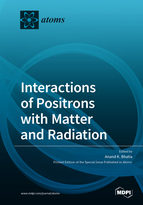Interactions of Positrons with Matter and Radiation
A special issue of Atoms (ISSN 2218-2004).
Deadline for manuscript submissions: closed (30 June 2020) | Viewed by 28273
Special Issue Editor
Interests: scattering and annihilation of positrons and electrons; Feshbach resonances; photoionization of atoms; muonic physics; Rydberg states; excitation of ions by electron and proton impact and their applications to astrophysics; photoionization; atomic structure calculations; Lamb shift
Special Issues, Collections and Topics in MDPI journals
Special Issue Information
Dear Colleagues,
Positrons can be used to study metallic defects. Positron annihilation experiments have been carried out to identify the defects in complex oxides. Positrons have also been used to study the Bose–Einstein condensation (BEC). Ps-BEC can be used to measure antigravity using atomic interferometers. This Special Issue hopes to bring awareness of the various aspects of positron interactions to the larger physics communities. We invite authors to submit articles from all areas of physics.
Dr. Anand K. Bhatia
Guest Editor
Manuscript Submission Information
Manuscripts should be submitted online at www.mdpi.com by registering and logging in to this website. Once you are registered, click here to go to the submission form. Manuscripts can be submitted until the deadline. All submissions that pass pre-check are peer-reviewed. Accepted papers will be published continuously in the journal (as soon as accepted) and will be listed together on the special issue website. Research articles, review articles as well as short communications are invited. For planned papers, a title and short abstract (about 100 words) can be sent to the Editorial Office for announcement on this website.
Submitted manuscripts should not have been published previously, nor be under consideration for publication elsewhere (except conference proceedings papers). All manuscripts are thoroughly refereed through a single-blind peer-review process. A guide for authors and other relevant information for submission of manuscripts is available on the Instructions for Authors page. Atoms is an international peer-reviewed open access monthly journal published by MDPI.
Please visit the Instructions for Authors page before submitting a manuscript. The Article Processing Charge (APC) for publication in this open access journal is 1500 CHF (Swiss Francs). Submitted papers should be well formatted and use good English. Authors may use MDPI's English editing service prior to publication or during author revisions.
Keywords
- Positron Collisions and Annihilation
- Positron physics
- Positron interactions






